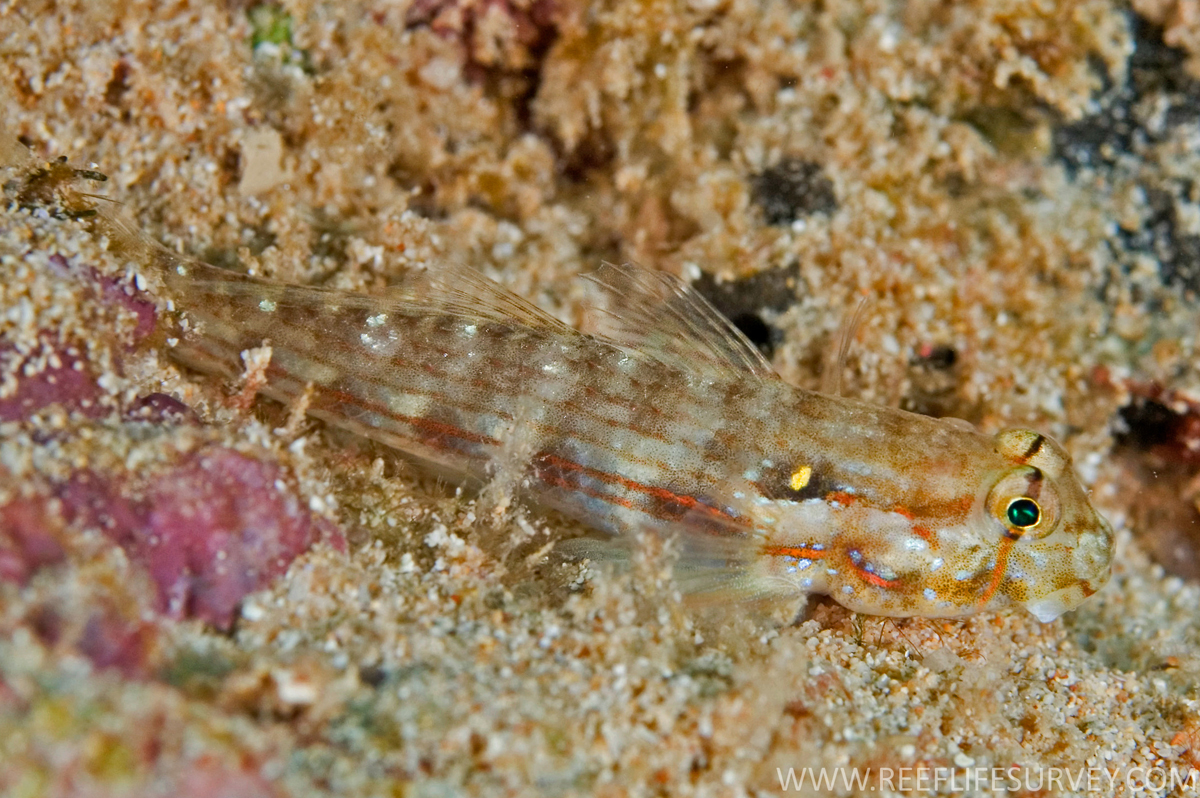- Classification
- ACTINOPTERYGII
- PERCIFORMES
- GOBIIDAE
- Gnatholepis
- cauerensis
Shoulderspot Goby, Gnatholepis cauerensis (Bleeker 1853)
Other Names: Eye-bar Sand-goby, Shoulder-spot Sandgoby

Gnatholepis cauerensis at North Murion Island, Ningaloo Marine Park, Western Australia. Source: Andrew J. Green / Reef life Survey. License: CC by Attribution
Summary:
A whitish to pale grey sand-dwelling goby with a dark bar through the eye and across the top of the head, rows of close-set reddish to dark-brown spots along the sides, and a small orange spot above the pectoral-fin base.
Cite this page as:
Bray, D.J. 2022, Gnatholepis cauerensis in Fishes of Australia, accessed 01 Jul 2025, https://fishesofaustralia.net.au/Home/species/901
Shoulderspot Goby, Gnatholepis cauerensis (Bleeker 1853)
More Info
|
Distribution |
Rottnest Island to offshore reefs of north Western Australia (including Ningaloo Reef), Cartier Island in the Timor Sea, and the northern Great Barrier Reef, Queensland, to Sydney, New South Wales; also Cocos (Keeling) Islands and Christmas Island in the eastern Indian Ocean, and the Lord Howe Province in the Tasman Sea. Elsewhere the species is widespread in the tropical, Indo-west-central Pacific. |
|
Etymology |
The species is named cauerensis for the type locality Cauer (plus –ensis, a suffix denoting place), a village on the southwestern coast of Sumatra, Indonesia. |
|
Species Citation |
Gobius cauerensis Bleeker, 1853, Natuurwetensch. Tijdschr. Nederland. Indië 4: 269. Type locality: Cauer, Sumatra, Indonesia. |
|
Author |
Bray, D.J. 2022 |
|
Resources |
Shoulderspot Goby, Gnatholepis cauerensis (Bleeker 1853)
References
Acero, A., Dominici-Arosemena, A. & Murdy, E. 2010. Gnatholepis cauerensis (errata version published in 2017). The IUCN Red List of Threatened Species 2010: e.T154848A115242256. https://dx.doi.org/10.2305/IUCN.UK.2010-4.RLTS.T154848A4649849.en. Accessed on 10 March 2022.
Allen, G.R. 2007. New species description. pp. 282 in Allen, G.R., Steene, R.C. & Orchard, M. Fishes of Christmas Island. Christmas Island : Christmas Island Natural History Association 2 edn, 284 pp.
Allen, G.R. & Erdmann, M.V. 2012.Reef fishes of the East Indies. Perth : Tropical Reef Research 3 vols, 1260 pp.
Allen, G.R., Hoese, D.F., Paxton, J.R., Randall, J.E., Russell, B.C., Starck, W.A., Talbot, F.H. & Whitley, G.P. 1976. Annotated checklist of the fishes of Lord Howe Island. Records of the Australian Museum 30(15): 365-454 figs 1-2 (p. 430, as Gnatholepis inconsequens)
Allen, G.R. & Smith-Vaniz, W.F. 1994. Fishes of Cocos (Keeling) Islands. Atoll Research Bulletin 412: 1-21.
Bleeker, P. 1853. Diagnostische beschrijvingen van nieuwe of weinig bekende vischsoorten van Sumatra. Tiental V–X. Natuurwetenschappelijk Tijdschrift voor Nederlandsch Indië 4: 243-302.
Brandl, S.J., Quigley, C.N., Casey, J.M., Mercière, A., et al. 2022. Metabolic rates mirror morphological and behavioral differences in two sand-dwelling coral reef gobies. Marine Ecology Progress Series 684: 79-90. https://doi.org/10.3354/meps13968
Gill, A.C. & Reader, S.E. 1992. Fishes. pp. 90-93, 193-228 in Hutchings, P. (ed.) Reef Biology. A Survey of Elizabeth and Middleton Reefs, South Pacific. Canberra : Australian National Parks Vol. 3, Kowari 230 pp.
Goren, M. 1981. Three new species and three new records of gobies from New Caledonia. Cybium 3e 5(3): 93-101 figs 1-5
Herre, A.W.C.T. 1953. A new species of Gnatholepis with a key to the tropical Pacific species. Philippine Journal of Science 82(2): 193-197 (described as Gnatholepis scapulostigma, type locality Engebi Island, Eniwetok (as Enewetak) Atoll, Marshall Islands)
Hobbs, J-P.A., Newman, S.J., Mitsopoulos, G.E.A., Travers, M.J., Skepper, C.L., Gilligan, J.J., Allen, G.R., Choat, H.J. & Ayling, A.M. 2014. Checklist and new records of Christmas Island fishes: the influence of isolation, biogeography and habitat availability on species abundance and community composition. Raffles Bulletin of Zoology Supplement 30: 184–202
Hobbs, J-P.A., Newman, S .J., Mitsopoulos, G.E.A., Travers, M.J., Skepper, C.L., Gilligan, J.J., Allen, G.R., Choat, H.J. & Ayling, A.M. 2014. Fishes of the Cocos (Keeling) Islands: new records, community composition and biogeographic significance. Raffles Bulletin of Zoology Supplement 30: 203–219
Johnson, J.W. 2010. Fishes of the Moreton Bay Marine Park and adjacent continental shelf waters, Queensland, Australia. pp. 299-353 in Davie, P.J.F. & Phillips, J.A. Proceedings of the Thirteenth International Marine Biological Workshop, The Marine Fauna and Flora of Moreton Bay. Memoirs of the Queensland Museum 54(3)
Kuiter, R.H. 1993. Coastal Fishes of South-eastern Australia. Bathurst : Crawford House Press 437 pp. (as Gnatholepis scapulostigma)
Larson, H.K. & Buckle, D.J. 2012. A revision of the goby genus Gnatholepis Bleeker (Teleostei, Gobiidae, Gobionellinae), with description of a new species. Zootaxa 3529: 1–69.
Randall, J.E. 2005. Reef and shore fishes of the South Pacific. New Caledonia to Tahiti and the Pitcairn Islands. Honolulu : University of Hawaii Press 707 pp.
Randall, J.E., Allen, G.R. & Steene, R. 1990. Fishes of the Great Barrier Reef and Coral Sea. Bathurst : Crawford House Press 507 pp. figs. (as Gnatholepis scapulostigma)
Randall, J.E. & Greenfield, D.W. 2001. A preliminary review of the Indo-Pacific gobiid fishes of the genus Gnatholepis. Ichthyological Bulletin of the J.L.B. Smith Institute, Grahamstown 69: 1-17 (as Gnatholepis anjerensis, in part)
Thacker, C.E. 2004. Phylogeny and species boundaries in the gobiid genus Gnatholepis (Teleostei: Perciformes). Journal of the Linnean Society of London, Zoology 142(4): 573-582 (as Gnatholepis anjerensis, in part)
Whitley, G.P. 1958. Descriptions and records of fishes. Proceedings of the Royal Zoological Society of New South Wales 1956–57: 28-51 figs 1-12 (described as Gnatholepis inconsequens, type locality Heron Island, Queensland)











